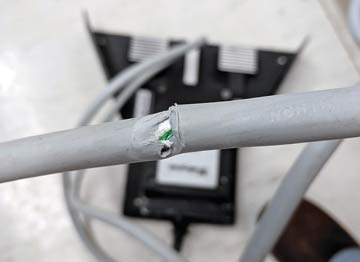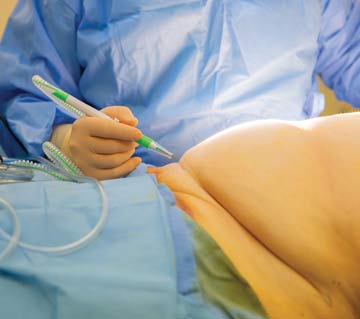Electrosurgical injuries are estimated to occur in 1 to 2 out of every 1,000 laparoscopic procedures. That doesn't seem like many, but when you consider about 2 million cases involving surgical energy instruments are performed in the U.S. each year, these figures are cause for alarm — and re-education. After all, electrosurgical injuries are preventable. With that in mind, let's look at the most common electrosurgery failures that lead to patient injuries as well as the practical steps you can take to prevent these negative outcomes from taking place at your facility.
- Home
- Article
Understanding Electrosurgery Safety
By: Leena Khaitan
Published: 11/14/2019
Practical pointers for protecting patients from stray current and hot instruments.
1. Insulation breaches
Small amounts of current can leak through minute breaks and small cracks in the shaft of an electrosurgical instrument and stray from the intended energy path to cause small electrical burns to non-targeted areas of tissue. These burns can lead to internal bleeding, lesions and infection. Insulation breaks can be caused by mistreatment of instruments during reprocessing or wear and tear from routine use.
Insulation failure is one of the top reasons for electrosurgery injuries during laparoscopic procedures; research has found that 1 in 5 reusable laparoscopic instruments have an insulation failure. The smaller the break, the higher the amount of current that flows through it. While breaks in the distal third of the laparoscopic instrument are the most common cause of insulation failures, the most dangerous breaks occur in the mid-shaft area, which surgeons can't see during procedures.

Because many insulation breaks aren't visible to the naked eye, sterile processing techs should use porosity detectors to identify defects. Surgeons, meanwhile, should take a moment before procedures begin to run their hands down the laparoscopic instrument to make sure they don't feel any apparent breaks. Surgeons can also reduce incidents related to insulation failure by setting instruments to the safest mode — ?the lowest power setting that's still effective and efficient — and paying close attention during surgery to prevent the shaft from touching adjacent tissue. Automated electrode monitoring (AEM) — technology that automatically shuts down generator response systems when stray current is detected — is another proven preventative tactic.
2. Stray energy
Direct application failures occur when heat that's distributed during the normal activation of an instrument injures adjacent structures like non-targeted tissue. Surgeons must be careful to prevent burns caused by the lateral spread of energy based on the device they're using and the location of the instrument within the surgical field. Luckily, a few simple, intuitive steps can prevent these types of injuries. It starts with understanding the properties of individual instruments, including the distance of the device's lateral spread of energy. Surgeons should use this knowledge to ensure there's adequate space between the tip of the activated device and vulnerable tissue. Surgeons should also use the lowest possible effective power setting and employ short activation bursts whenever possible.
3. Residual heat
The tips of electrosurgery instruments remain very hot, even after the devices are deactivated, so burns can occur if the surgeon isn't aware of this risk factor and accidentally touches the tip to a non-targeted area. Surgeons should be careful with the residual heat associated with all electrosurgical devices, but also aware that ultrasonic devices have higher residual heat than mono- or bipolar equipment.
Again, an understanding of electrosurgery instruments is paramount. When using ultrasonic devices, surgeons should avoid touching the tip of the device to vulnerable tissue immediately after the energy activation. To avoid collateral damage when moving ultrasonic instruments into and out of the abdomen, surgeons must always be aware that the devices stay hot for a long time. Ideally, they should have direct visualization of the instrument's blade to avoid inadvertently nicking a piece of the bowel or burning the patient. Instead of inserting an ultrasonic instrument into the surgical field along the lower part of the abdomen, it's safer to maneuver it along the anterior abdominal wall, away from vital organs.
4. Dangerous touches
Direct coupling occurs when there's a transfer of electrosurgical energy from one conductor to another, such as when the surgeon inadvertently touches an electrosurgery device to another instrument or activates the device in close proximity to uninsulated metal objects such as clips or staples. To avoid direct coupling, surgeons should always keep the tip of the electrosurgery instrument in view, be the sole person in the OR who activates the instrument and never activate the energy when the instrument is touching a trocar.
5. Unexpected energy flows
Capacitive coupling occurs when the electrical circuit is transferred from an instrument's active electrode through intact insulation — an internal organ, for example — to adjacent conductive material without direct contact. Factors that increase the risk of capacitive coupling include using a high-voltage setting like coagulation; the laparoscopic cannula diameter (for example, the risk is greater with when energy is delivered through a 5mm instrument than through a 11mm instrument); and activating the instrument when the electrode isn't in contact with tissue, a practice that increases the voltage; and any activation over previously desiccated tissue due to the tissue's high resistance to the electrical current flow.
On the Web

For information about electrosurgery safety, check out the Fundamental Use of Surgical Energy (FUSE) program (fuseprogram.org) offered by the Society of American Gastrointestinal and Endoscopic Surgeons.
With these risk factors in mind, you can avoid capacitive coupling by reducing your devices to lowest possible wattage setting. Additionally, surgeons should activate an instrument only when its tip is in direct contact with the target tissue. Finally, they should use only short bursts of activation whenever possible.
Continuing education
Although electrosurgical failures are rare, when they do occur, they are truly devastating to everyone involved — surgeons, facilities and, above all, patients. Surgeons often don't know what they don't know. They often think they have a solid understanding of surgical energy simply because they use electrosurgery devices on a daily basis, but unless they have a more formalized training on the subject, they're likely to have knowledge gaps that they don't even realize they have. Take the steps to educate yourself and your surgeons about how surgical energy works and what can be done to ensure it's used safely. OSM

There's a lot of equipment involved in electrosurgery and surgical teams often bundle the equipment's cords together to eliminate a spaghetti of tangled mess on the sterile field. Bundling, however, increases the risk of energy being transferred from the cord powering electrosurgery instrument to adjacent cords. To avoid this issue, separate the wires connecting electrosurgical instruments to the electrosurgical generator from the laparoscope's light source wire and camera cords.
Managing the fiberoptic light source is an important aspect of surgical fire prevention during laparoscopic procedures. If the light source is turned on and the light cord touches the surgical drapes, the drapes can ignite in seconds. The light source should always be on standby mode and in the safety holster before the case begins. When the light is turned on during surgery, the circulating nurse should inform the surgeon, who verbalizes his acknowledgement and indicates the cord is in a safe place. Finally, at the end of the case, the light source should be turned off and disconnected.
.svg?sfvrsn=be606e78_3)
.svg?sfvrsn=56b2f850_5)